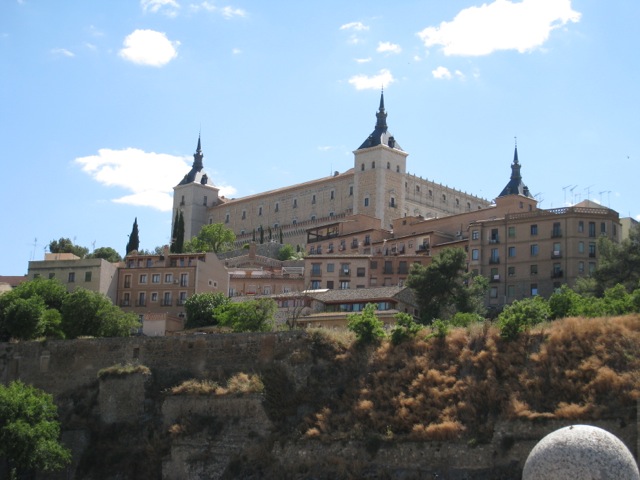October 1994: Dusk was falling when we left Zermatt, Switzerland, for Italy. By the time we reached our hotel in Bellagio, it was too dark to see anything outdoors. However, I do recall being duly impressed with the interior decor, with its white marble and lavender and purple accents. Since our visit, the hotel has been remodeled and the contemporary touches and colors are gone, replaced with a more old-world decor.
We woke to a sunny, clear morning with a beautiful, panoramic view of Lake Como from the balcony of our room. Stuffed after a lavish brunch buffet, we hiked the narrow streets of Bellagio to shop for Murano glassware and a few souvenirs.
In the afternoon, we took a nail-biting drive around the lake with its narrow roads, hairpin curves, steep inclines, and heavy traffic. We didn’t worry about the road conditions as much as the inexperienced drivers, who often came around a sharp corner in the middle of the road.
From Bellagio, we drove through the Italian Alps to St. Moritz, where we lunched, then wound our way into Innsbruck for a day of shopping and sightseeing. Up early the next morning, we left Innsbruck for Füssen, in Bavaria, to tour King Ludwig II’s three castles: Hohenschwangau, Neuschwanstein, and his final retreat, Linderhof.
In Füssen we backtracked to the Autobahn and zipped into Munich to meet friends for Oktoberfest, staying long enough to catch up over a beer and brat, and to buy a souvenir beer mug before we sped down to Salzburg, Austria, for the night.
The next day, we toured Hohensalzburg Castle, wandered through Mirabell Palace and Gardens, and visited Mozart’s birthplace. Later in the day, the tea hour, we lingered over an espresso and a generous slice of Sachertorte (chocolate cake with apricot jam and dark chocolate icing).
Early the next morning, we left Salzburg for a two-day visit to Vienna, both of us ready to put down stakes for a while after admitting we had packed too much sightseeing into our three-week trip.
In Vienna, we started our first day with a visit to St. Stephen’s Cathedral. At noon, we stopped at the Hoher Markt Clock, a large glided clock designed in 1914, to watch the parade of all the figures and to listen to the melodic music that accompanied the procession. Afterwards, we toured the Imperial Palace (Hofburg).
On day two in Vienna, due to a misunderstanding by our hotel’s concierge, we missed out on our original plan to take a boat ride down the Danube to Budapest. By the time the matter had been cleared up, our boat had already departed. However, many years later, we would visit Budapest and for much longer than just one day. So day two began at Belvedere Palace and a visit to St. Charles’s Church, completing the evening with a boat ride on the Danube.
When we left Vienna, we drove along the Danube to Melk until the road detoured from the river. Here, we veered inland and sped onto the Autobahn for Passau, Germany. I wanted to see where the three rivers converged: the green Inn, the black Ilz, and the blue Danube. History says the rivers brought wealth to Passau. I saw only beauty as the three flowed into one.
Hugging the Danube, we left Passau for Regensburg, the Danube River’s oldest medieval town. First on our sightseeing agenda was the ancient Stone Bridge with its sixteen curving arches, but we soon discovered that this charming town had a lot more to offer, so we set off on foot to explore. After leaving the bridge, we paused to snap pictures of the clock tower before we entered the city center. Our destination? The Cathedral of St. Peter (Trierer Dom). On our afternoon jaunt back to our hotel, we came across Historisches Eck and made reservations for dinner. Our five-course meal was superb.
We said goodbye to Regensburg and drove into Würzburg, interested in seeing the Residenz, the former residence of the prince bishops. While my husband lingered to admire the architecture of the building, I toured the court gardens, my sights set on the orangery. Next, we headed for the Festung Marienberg, the fortress with stunning views of the town. We saved the afternoon for a long stroll across the Alte Mainbruecke, pausing on the bridge to enjoy the vistas: the fortress high on the hill surrounded by vibrant green vineyards, the melody of the river as it constantly flowed below us, and the sight of the medieval town itself. Warmed by the afternoon sun, we wound our way through the crowds of tourists and locals, who were sipping wine or beer while listening to the musicians play. I stopped to take pictures at each of the twelve statues: two kings and ten saints that were added to the bridge by the prince-bishops from 1724 to 1746.
Road-weary on our last day, we checked into our hotel in Frankfurt and flew home the following day. My first long trip through Europe was fun, and I would return many years later, especially to Bellagio, where part of a future Darcy McClain novel will be set.



